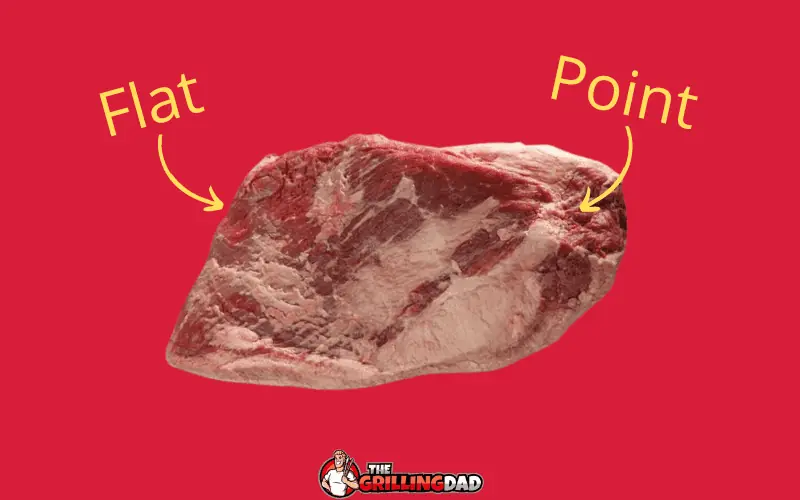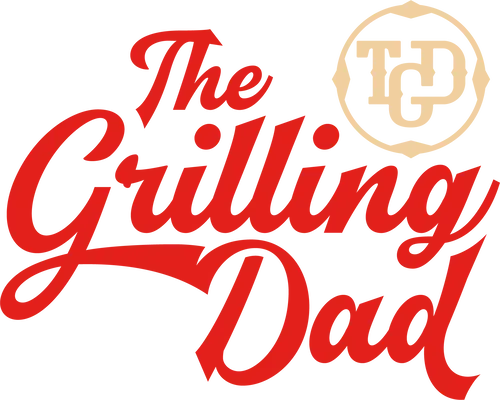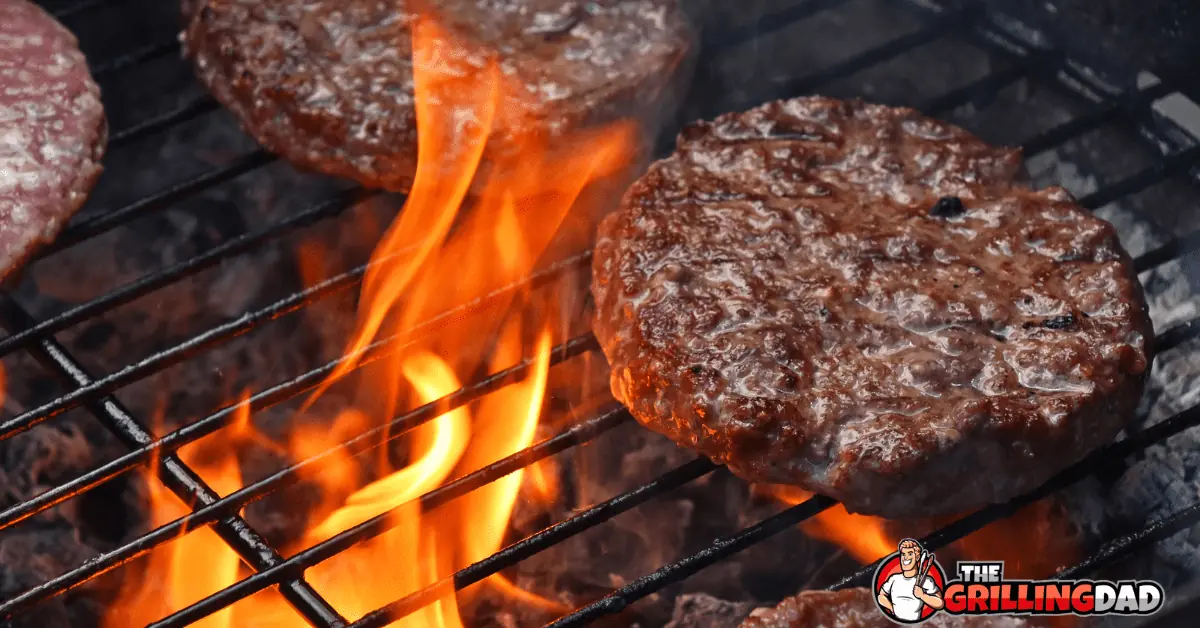If you want to know the difference between the brisket flat and the point, you’re in the right place!
In this TheGrillingDad.com guide, you’ll learn:
- The differences
- Which is better
- And much more!
If you’re new to BBQing, you may be wondering what the difference is between a brisket flat and a brisket point. Both cuts come from the same piece of meat, but they have different names and serve different purposes. It’s essential to know the difference so that you can decide which one is right for your next BBQ.
To gain a better understanding of brisket flat vs. point, let’s take a closer look at each cut.
Jump to Section
What Is Brisket and Where Does it Come From on the Cow?
Brisket is a relatively tough cut of beef that comes from the breast or pectoral region of the cow. This area of the cow gets a lot of exercise, which makes the meat strong and full of flavor. Because brisket is such a tough cut, it benefits from long, slow cooking methods like braising or smoking.
Related >> Smoked Brisket Recipe
This breaks down the tough connective tissue and results in juicy, tender meat that is packed with flavor you’ll love.
Whether you’re looking for a traditional favorite or something new to try, brisket is an excellent option for your next meal because it’s savory and relatively easy to prepare. Brisket is often used in barbecue recipes, and it’s also a popular choice for corned beef.
Related >> Corned Beef vs. Brisket: What’s the Difference?
The brisket is made up of two parts: the flat and the point.
While both sections are good for cooking, they have some differences that you should be aware of.
How to Identify the Point and the Flat
When it comes to brisket, there are two main cuts: the point and the flat.
Brisket Point
The point is the upper part of the brisket; this is generally more marbled with fat and is also known as the deckle.
Brisket Flat
The flat is the lower part of the brisket, which tends to be leaner and is also referred to as the brisket plate.
How To Identify Them
These cuts are divided by a thick layer of fat. Depending on your preference, you can choose either cut when you purchase a whole brisket and have it trimmed.
To identify the two cuts, lay out the brisket on the table with the fatty side down. You will see a thick seam where the point and the flat meet because the flat is positioned directly on top of the point.
Finding the tip and the flat is the next step in preparing your brisket, but don’t worry, it isn’t difficult. The tip is usually smaller and darker in color, while the flat is larger and lighter in color. Once you’ve identified them, you can trim any excess fat off of the brisket.

Brisket Flat vs. Point — Which Is Better for Smoking or Grilling?
Like any other cuisine community, there are debates among avid barbecuers between brisket flat vs. brisket point. This is because both brisket cuts come from the same area of the cow, but they are very different.
The differences between the two brisket cuts can be confusing, but with the right information, you can decide which is best for your needs. It is also crucial to know which cut is better for smoking or grilling to get the most flavor out of your meat and avoid any tough or dry brisket.
Related >> Tri-Tip vs Brisket: Which is Better for Your Next BBQ?
Is the Brisket Flat Good for Smoking?
The brisket flat is a great choice for smoking and getting those perfect slices due to its flat and uniform shape. As the name suggests, this cut of brisket is much flatter than other cuts, making it easier to slice thinly.
Related >> How To Slice Brisket
Additionally, the flat shape ensures that each slice will be of uniform thickness. This is especially important when cooking for large groups, as it ensures that each person will get a similar piece of meat.
The brisket flat is also a good choice for those who prefer leaner meat, as it has less fat than other cuts of brisket. If you’re looking for a cut of brisket that’s lean and easy to slice, the brisket flat is a perfect choice.
Related >> Lean vs Moist Brisket: A Comparison for BBQ Lovers
Brisket Point
The brisket point is the fattier section of the brisket. It’s located closer to the navel, and it has a higher fat-to-meat ratio than that of brisket flat.
The extra fat makes the point more flavorful, but it also makes it harder to chew. For this reason, many people shred or chop this part of the brisket instead of slicing it. If you do slice the point, you’ll get larger pieces of meat that are easier to chew. However, the downside is that you’ll also get more fat per slice. If you’re a fan of fatty cuts, this won’t be a problem.
Just be aware that the point is usually more expensive than the flat because of its higher fat content. Slicing is an option, but it’s better chopped into cubes or turned into burnt ends.
Related >> Brisket Burnt Ends Recipe
How to Cook a Brisket Flat or Point for Best Results
If you’re planning to cook a brisket, you need to understand that these cuts of meat require different cooking methods to bring out the best in their flavors. However, there are cooking methods that will make both cuts mouthwatering, like they were prepared by a professional. Each of these methods will give your brisket a different flavor, so choose the one that best fits your tastes.
Here are the four ways you can cook a brisket flat or point:
Smoking
This is the most common method for cooking a brisket. It involves cooking the meat over low heat for several hours until it’s tender. Smoking brisket will, unsurprisingly, give it a smoky flavor that’s perfect for those who love the taste of barbecue. The key to smoking brisket is to simmer it so that the fat has time to render and the meat doesn’t dry out.
Related >> Hot and Fast Brisket Recipe
Braising
Braising is a method of cooking that involves browning the meat in a pan before adding it to a pot of liquid. The liquid can be anything from water to wine, and it helps to tenderize the meat as it cooks. Braising brisket will give it a rich flavor that’s perfect for those who love hearty meals.
Stovetop Cooking
When cooking brisket on the stovetop, all you have to do is add all of your ingredients to a pot and let it simmer until the meat is cooked through. The key to this method is to simmer the meat for several hours until it is tender. This is perfect for those who want to cook their brisket soft, tender, and flavorful at the same time.
Oven Roasting
If you want to give your brisket a more intense flavor, you can try oven roasting. This involves putting the meat in a roasting pan and cooking it at a high temperature for a shorter period of time. Oven roasting brisket will give it a crispy exterior that is perfect for those who love crunchy food.
Related >> How Big is a Brisket? A Guide on Meat Cut Size
Final Thoughts on Brisket Cuts
In the end, it’s up to you whether you want to cook a brisket flat or a brisket point. With your newfound understanding of the difference between these two cuts of meat, you can make an informed decision next time you’re at the butcher or grocery store. Whichever you choose, make sure to cook it low and slow for the best results.
With a bit of practice, you’ll be a brisket master in no time.






Very concise information. Thank you. I did not even remember this from old college course. Stores indicate cut type, but I still did not really know the difference.